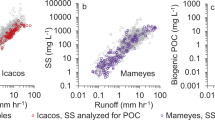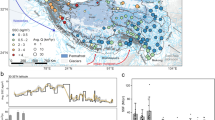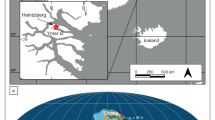Abstract
The timing and magnitude of increases in the flux of atmospherically-derived anthropogenic substances to remote areas can be estimated from their distributions in lake sediments. For transition metals1–4 or trace organics5–7, this is done simply by comparing their distributions with that of geochronological tracers. This approach is not directly applicable to species which exhibit significant post-depositional mobility. Diagenetic mobilization must be assessed from the distribution of the species in the sediment pore waters. However, by using this and related information, loading histories can be calculated. We have done this for sulphate, the major anionic component of modern precipitation8–11, for a watershed located in the Adirondack Mountains of New York State. Our results suggest that previous estimates for the onset of increased sulphur deposition in eastern North America12,13 are too old by a factor of about two, and that significant increases did not occur until about 1930.
This is a preview of subscription content, access via your institution
Access options
Subscribe to this journal
Receive 51 print issues and online access
$199.00 per year
only $3.90 per issue
Buy this article
- Purchase on Springer Link
- Instant access to full article PDF
Prices may be subject to local taxes which are calculated during checkout
Similar content being viewed by others
References
Galloway, J. N. & Likens, G. E. Limnol. Oceanogr. 24, 427–433 (1979).
Wahlen, M. & Thompson, R. C. Geochim. cosmochim. Acta 44, 333–339 (1980).
Johnston, S. E., Norton, S. A., Hess, C. T., Davis, R. B. & Anderson, R. S. Energy and Environmental Chemistry Vol. 2 (ed. Keith, L. W.) 177–188 (Ann Arbor Science, 1982).
Kahl, J. S., Norton, S. A. & Williams, J. S. Geologic Aspects of Acid Deposition Vol. 7 (ed. Bricker, O. P.) (Ann Arbor Science, 1984).
Heit, M., Tan, Y., Klusek, C. & Burke, J. C. Wat., Air Soil Pollut. 15, 441–464 (1981).
Eisenreich, S. J., Rappaport, R., Urban, N., Capel, P. & Looney, B. Proc., Paleolimnological Analysis of the Impact of Acidic Precipitation and Related Pollutants on Lake Ecosystems (ed. Norton, S. A.) (Rockport, Maine, 1984).
Hites, R. A. Proc., Paleolimnological Analysis of the Impact of Acidic Precipitation and Related Pollutants on Lake Ecosystems (ed. Norton, S. A.) (Rockport, Maine, 1984).
Junge, C. E. & Werby, R. T. J. Met. 15, 417–425 (1958).
Gambell, A. W. & Fisher, D. W. J. geophys. Res. 69, 4203–4210 (1964).
Gambell, A. W. & Fisher, D. W. US geol. Surv. Wat-Supply Pap. 1535-K (1966).
Likens, G. E., Bormann, F. H., Pierce, R. S., Eaton, J. S. & Johnson, N. M. Biogeochemistry of a Forested Ecosystem (Springer, Berlin, 1977).
Nriagu, J. O. & Coker, R. D. Nature 303, 692–694 (1983).
Mitchell, M. J., David, M. B. & Uutala, A. J. Hydrobiology (in the press).
Casagrande, D. J. & Siefert, K. Science 195, 675–676 (1977).
Mitchell, M. J., Landers, D. H. & Brodowski, D. F. Wat., Air Soil Pollut. 16, 351–359 (1981).
Mitchell, M. J., Landers, D. H., Brodowski, D. F., Lawrence, G. B. & David, M. B. Wat., Air Soil Pollut. 21, 231–245 (1984).
Berner, R. A. Am. J. Sci. 268, 1–23 (1970).
Nriagu, J. O. Limnol. Oceanogr. 13, 430–439 (1968).
Rao, S. S. & Dutka, B. J. Hydrobiology 98, 153–157 (1983).
Cook, R. B. & Schindler, D. W. Ecol. Bull., Stockh. 35, 115–127 (1981).
Nriagu, J. O. & Coker, R. D. Limnol. Oceanogr. 21, 485–489 (1976).
Brunelle, T. M. thesis, Univ. Rochester (1984).
Tobin, R. S. & Anthony, D. H. J. Limnol. Oceanogr. 23, 161–165 (1978).
Hesslein, R. H. Limnol. Oceanogr. 21, 912–914 (1976).
Berner, R. A. Early Diagenesis (Princeton University Press, 1980).
Goldhaber, M. B. et al. Am. J. Sci. 277, 193–237 (1977).
Aller, R. C. Adv. Geophys. 22, 237–350 (1980).
Galloway, J. N. & Whelpdale, D. M. Atmos. Envir. 14, 409–417 (1980).
Bilonick, R. A. & Nichols, D. G. Atmos. Envir. 17, 1063–1072 (1983).
Li, Y.-H. & Gregory, S. Geochim. cosmochim. Acta 38, 703–714 (1974).
Author information
Authors and Affiliations
Rights and permissions
About this article
Cite this article
Holdren, G., Brunelle, T., Matisoff, G. et al. Timing the increase in atmospheric sulphur deposition in the Adirondack Mountains. Nature 311, 245–248 (1984). https://doi.org/10.1038/311245a0
Received:
Accepted:
Issue Date:
DOI: https://doi.org/10.1038/311245a0
This article is cited by
-
Seasonal diatom community responses to development and climate change in Lake George, an oligotrophic lake in the Adirondack Mountains
Hydrobiologia (2022)
-
Lake Sediment Core Records of Sulphur Accumulation and Sulphur Isotopic Composition in Central Ontario, Canada Lakes
Journal of Paleolimnology (2006)
-
Historical loading record of sulfur in an Adirondack Lake
Journal of Paleolimnology (1993)
-
Stratigraphy of total metals in PIRLA sediment cores
Journal of Paleolimnology (1992)
-
Comparison of sulfur concentrations within lake sediment profiles
Hydrobiologia (1988)
Comments
By submitting a comment you agree to abide by our Terms and Community Guidelines. If you find something abusive or that does not comply with our terms or guidelines please flag it as inappropriate.



